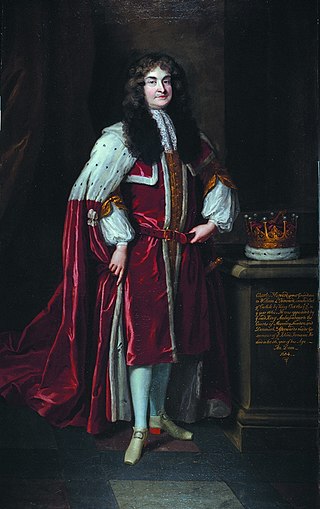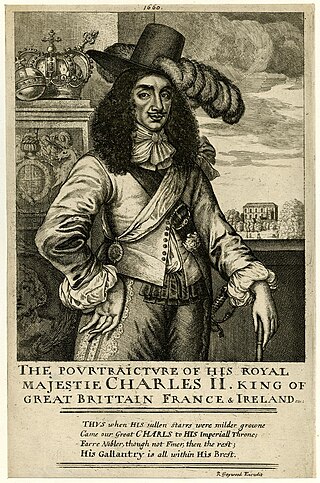Related Research Articles

The Stuart Restoration was the reinstatement in May 1660 of the Stuart monarchy in England, Scotland, and Ireland. It replaced the Commonwealth of England, established in January 1649 after the execution of Charles I, with his son Charles II.

Charles Howard, 1st Earl of Carlisle was an English military leader and politician who sat in the House of Commons at various times between 1653 and 1660 and was created Earl of Carlisle in 1661.

The Anglo-Spanish War was a conflict between the English Protectorate and Spain between 1654 and 1660. It was driven by the economic and religious rivalry between the two countries, with each side attacking the other's commercial and colonial interests in various ways, such as privateering and naval expeditions.

The Wars of the Three Kingdoms were a series of conflicts fought between 1639 and 1653 in the kingdoms of England, Scotland and Ireland, then separate entities in a personal union under Charles I. They include the 1639 to 1640 Bishops' Wars, the First and Second English Civil Wars, the Irish Confederate Wars, the Cromwellian conquest of Ireland and the Anglo-Scottish War of 1650–1652. They resulted in the execution of Charles I, the abolition of monarchy, and founding of the Commonwealth of England, a unitary state which controlled the British Isles until the Stuart Restoration in 1660.
Francis Willoughby, 5th Baron Willoughby of Parham was an English peer of the House of Lords.

William Stone was an English-born merchant, planter and colonial administrator who served as the proprietary governor of Maryland from 1649 to 1655.

Robert Searle was one of the earliest and most active of the English buccaneers on Jamaica.
Josias Fendall(c. 1628 – c. 1687) was an English colonial administrator who served as the Proprietary Governor of Maryland. He was born in England, and came to the Province of Maryland. He was the progenitor of the Fendall family in America.
Colonel Sir Thomas Modyford, 1st Baronet was a planter of Barbados and Governor of Jamaica from 1664 to 1671.

The Battle of the Severn was a skirmish fought on March 25, 1655, on the Severn River at Horn Point, across Spa Creek from Annapolis, Maryland, in what at that time was referred to as the Puritan settlement of "Providence", and what is now the neighborhood of Eastport. It was an extension of the conflicts that formed the English Civil War, pitting the forces of Puritan settlers against forces aligned with Lord Baltimore, then Lord Proprietor of the colony of Maryland. It has been suggested by Radmila May that this was the "last battle of the English Civil War."
Between 1639 and 1651 English overseas possessions were involved in the Wars of the Three Kingdoms, a series of civil wars and wars that were fought in and between England, Scotland and in Ireland.
Sir Tobias Bridge fought for Parliament in the English Civil War, and served the Lord Protector Oliver Cromwell during the Interregnum. After the Restoration, he served King Charles II.

From 1649 to 1660, Puritans in the Commonwealth of England were allied to the state power held by the military regime, headed by Lord Protector Oliver Cromwell until he died in 1658. They broke into numerous sects, of which the Presbyterian group comprised most of the clergy, but was deficient in political power since Cromwell's sympathies were with the Independents. During this period, the term "Puritan" becomes largely moot, therefore, in British terms, though the situation in New England was very different. After the English Restoration, the Savoy Conference and Uniformity Act 1662 and Great Ejection drove most of the Puritan ministers from the Church of England, and the outlines of the Puritan movement changed over a few decades into the collections of Presbyterian and Congregational churches, operating as they could as Dissenters under changing regimes.

The Restoration of the Monarchy of Ireland began in 1660. The Commonwealth of England, Scotland and Ireland (1649–1660) resulted from the Wars of the Three Kingdoms but collapsed in 1659. Politicians such as General Monck tried to ensure a peaceful transition of government from the "Commonwealth" republic back to monarchy. From 1 May 1660 the English, Scottish and Irish monarchies were all restored under King Charles II. The term Restoration may apply both to the actual event by which the monarchy was restored, and to the period immediately before and after the event.

The Restoration was the return of the monarchy to Scotland in 1660 after the period of the Commonwealth, and the subsequent three decades of Scottish history until the Revolution and Convention of Estates of 1689. It was part of a wider Restoration in the British Isles that included the return of the Stuart dynasty to the thrones of England and Ireland in the person of Charles II.
Humphrey Walrond, was acting Governor and later Deputy-Governor of Barbados

Surinam, also known as Willoughbyland, was a short-lived early English colony in South America in what is now Suriname. It was founded in 1650 by Lord Willoughby when he was the Royalist Governor of Barbados.

Sir James Modyford, 1st Baronet (1618–1673) was an English merchant, colonial agent, and deputy-governor of Jamaica.
References
- ↑ Higham, C.S. (1921). The Development of the Leeward Islands under the Restoration 1660-1688. p. 10.
- ↑ Higham 1921, pp. 12–14.
- ↑ Monteith, Kathleen; Richards, Glen, eds. (2001). Jamaica in Slavery and Freedom: History, Heritage and Culture. University of the West Indies Press. pp. 36–39.
- ↑ Bremers, Francis J. (1995). The Puritan Experiment: New England Society from Bradford to Edwards (Revised ed.). pp. 151–153.
- ↑ Middleton, Richard (2002). Colonial America: a history, 1565-1776 (3rd ed.). Blackwell. p. 111.
- ↑ Middleton 2002, p. 112.
- ↑ Beverley, Robert (1722). The History and Present State of Virginia. p. 51.
- ↑ Kennedy, David; et al. (2002). The American Pageant (12th ed.). Houghton Mifflin. p. 36.